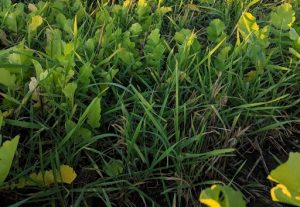Late Summer Early Fall Cover Crops
By James Hoorman, Hoorman Soil Health Services
Late summer and early fall are great opportunities to plant cover crops and improve soil health. Days are shorter, but with ample sunshine left and a little rain, cover crops grow quickly. Both summer annuals which die with the first frost and winter annuals can be grown. Legumes and clover which add soil nitrogen, all types of grasses for carbon, and brassicas to reduce soil compaction and reduce weeds all grow well at this time.
After wheat, either bale or chop the straw and spray the weeds. Baling straw makes you more money than chopping straw. The high carbon content in wheat straw can reduce cover crop establishment and the by-products upon decomposition may be toxic to germinating cover crop seedlings. If possible, spray weeds with gramoxone (a dessicant) rather than glyphosate. Glyphosate reduces soil health and biology for several weeks and causes oxidizing microbes to make manganese unavailable while promoting Fusarium root diseases and weed resistance. Oats do the opposite, promoting reducing organisms which makes manganese plant available and promotes many other beneficial soil organisms.

Planting options vary by crop. After wheat, drilling is the best but broadcasting seed (add 10-20% more seed) is possible with adequate rain (at least 1-2 inches). Voles, slugs, and earthworms can easily feed on broadcast seed, so drilling is always the best with good seed to soil contact. After corn silage harvest, drilling is best.
Inter-seeding into corn or soybeans starts in August or Early September once the corn leaves start to let light in or the soybeans leaves start to yellow. Inter-seeding too early may allow the seeds to germinate, but without light and adequate water, these weak seedlings may die out. Airplanes and helicopters can be used but High boy applicators (90-120 foot) usually give more consistent results.
Deciding what cover crop to plant depends on the purpose and what crop is to follow. Forage cover crops include Teff, Sorghum and Sudan varieties, forage oats, triticale, and cereal rye. Pollinators for beneficial insects include buckwheat, sunflower, and phacelia along with many legumes that bloom next year. The best cover crops for corn should include at least some legumes or clovers for nitrogen (N) and a brassica like radish, rape seed, or kale. For soybeans, grass cover crops like cereal rye (reduce Phytophthora, Rhizoctonia, soybean cysts), oats (reduces Fusarium), and barley make phosphorus available while reducing disease organisms.
For corn after wheat, legume possibilities include crimson or Balansa clover, Austrian winter peas (AWP), cow peas (CP), and hairy vetch (HV) which can all contribute 75-150# N/acre. Crimson is not as winter hardy or will not tolerate poor drainage like Balansa clover. AWP needs moisture and will generally die with a frost, but if planted early gives the most N while CP need very little moisture. HV need well drained soils, are good soil builders, and can produce 150-200# N but have hard seed. All legume and clover cover crops should be inoculated at planting with a specific inoculant for their species. Cover crop inoculant viability is typically 12-48 hours and are killed by sunlight and heat. Inoculating at planting pays dividends. Brassicas could include radish (<2#), rape seed, or kale which improve soil structure, reduce weed seed germination, while making sulfur more available. Beneficial grasses include oats (winter or spring) or annual ryegrass to improve soil carbon or promote beneficial organisms like mycorrhizae fungi and reducing gram-negative bacteria (pseudomonas).
For soybeans after wheat or corn silage, grasses need to predominate. Cereal rye is winter hardy and either winter oats

or spring oats add some diversity with a fifty-fifty mixture now recommended. Sorhum or Sudan varieites can be planted in August but remember they die with the first frost. Brassicas like radish, rape seed, or kale can be added at low rates. For best results, oats and barley need to be planted by the end of September or early October, but cereal rye is very hardy and planted later since germination starts at 32OF.
If inter-seeding cover crops into corn or soybeans, plant varieties that are shade tolerant (oats, cereal rye, annual ryegrass, cowpeas, winter peas, radish, crimson or Balansa clover, buckwheat). Corn going to soybeans should include oats, radish and/or cereal rye. Into soybeans going to corn; oats, radish and at least one legume or clover (crimson, Balansa, cowpea, winter pea). Late summer and early fall are prime times to plant cover crops to improve soil health.